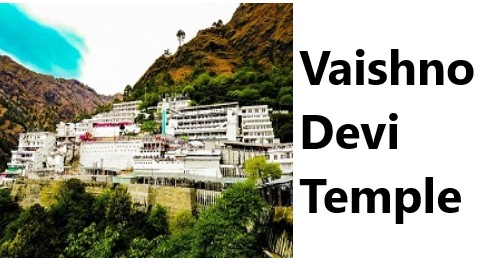Vaishno Devi Temple
Vaishno Devi Temple: The Vaishno Devi Temple is a significant Hindu temple dedicated to the goddess Vaishno Devi, located in the Trikuta Mountains of the Indian union territory of Jammu and Kashmir.
वैष्णो देवी मंदिर एक महत्वपूर्ण हिंदू मंदिर है जो देवी वैष्णो देवी को समर्पित है, जो भारतीय केंद्र शासित प्रदेश जम्मू और कश्मीर के त्रिकुटा पर्वत में स्थित है।
Key Historical Events:
Discovery of the Cave: The actual discovery of the cave is unclear historically, but it is believed that it gained prominence around 700 years ago.
Building of the Temple: The construction and organization around the temple gained momentum in the early 20th century when the area came under the administration of Maharaja Gulab Singh of Jammu and Kashmir.
प्रमुख ऐतिहासिक घटनाएँ:
गुफा की खोज: गुफा की वास्तविक खोज ऐतिहासिक रूप से अस्पष्ट है, लेकिन ऐसा माना जाता है कि इसे लगभग 700 साल पहले प्रसिद्धि मिली थी।
मंदिर का निर्माण: मंदिर के चारों ओर निर्माण और संगठन ने 20 वीं शताब्दी की शुरुआत में गति पकड़ी जब यह क्षेत्र जम्मू और कश्मीर के महाराजा गुलाब सिंह के प्रशासन के अधीन आ गया।
Cave Shrine: The temple is located inside a cave, which devotees trek through, covering a distance of approximately 12 kilometers from the base camp at Katra to the shrine.
गुफा मंदिर: मंदिर एक गुफा के अंदर स्थित है, जहां से होकर भक्त कटरा के आधार शिविर से मंदिर तक लगभग 12 किलोमीटर की दूरी तय करते हैं।
Mata Vaishno Devi Temple
The Vaishno Devi Temple, located in the northern Indian state of Jammu and Kashmir, is a renowned Hindu pilgrimage site dedicated to Goddess Vaishno Devi. Situated in the Trikuta Mountains, the temple attracts millions of devotees each year.
वैष्णो देवी मंदिर, उत्तरी भारतीय राज्य जम्मू और कश्मीर में स्थित, देवी वैष्णो देवी को समर्पित एक प्रसिद्ध हिंदू तीर्थ स्थल है। त्रिकुटा पर्वत पर स्थित यह मंदिर हर साल लाखों भक्तों को आकर्षित करता है।
The shrine is situated at an altitude of around 5,200 feet and involves a trek of approximately 12 kilometers from the base camp at Katra. Many pilgrims undertake this journey on foot as a mark of devotion, while others use ponies or palanquins.
यह मंदिर लगभग 5,200 फीट की ऊंचाई पर स्थित है और कटरा के आधार शिविर से लगभग 12 किलोमीटर की यात्रा करनी पड़ती है। कई तीर्थयात्री भक्ति के प्रतीक के रूप में पैदल ही यह यात्रा करते हैं, जबकि अन्य टट्टू या पालकी का उपयोग करते हैं।
The temple itself is a cave where devotees offer their prayers to Goddess Vaishno Devi in her three forms: Maha Kali, Maha Lakshmi, and Maha Saraswati. The journey to the temple is considered spiritually significant, and the legend goes that the Goddess grants the wishes of those who visit her with a pure heart.
यह मंदिर अपने आप में एक गुफा है जहां भक्त देवी वैष्णो देवी के तीन रूपों: महा काली, महा लक्ष्मी और महा सरस्वती की पूजा करते हैं। मंदिर की यात्रा को आध्यात्मिक रूप से महत्वपूर्ण माना जाता है, और किंवदंती है कि देवी उन लोगों की इच्छाएं पूरी करती हैं जो सच्चे दिल से उनके दर्शन करते हैं।
The Most Famous Story between Maa Vaishno Devi and Bhairon Nath
Goddess Vaishno Devi, also known as Mata Rani, is believed to be an incarnation of the Hindu Mother Goddess, Mahalakshmi, Mahakali, and Mahasaraswati. Legend has it that Vaishno Devi, in her earlier avatar as Vaishnavi, took birth to annihilate the demon, Bhairon Nath.
देवी वैष्णो देवी, जिन्हें माता रानी के नाम से भी जाना जाता है, हिंदू मातृ देवी, महालक्ष्मी, महाकाली और महासरस्वती का अवतार मानी जाती हैं। किंवदंती है कि वैष्णो देवी ने, वैष्णवी के रूप में अपने पहले अवतार में, राक्षस भैरो नाथ का विनाश करने के लिए जन्म लिया था।
According to the legend, Bhairon Nath, a tantric (a practitioner of esoteric rituals and magic), chased Vaishno Devi with ill intentions. During her journey, Vaishno Devi took refuge in a cave in the Trikuta Mountains. Bhairon Nath continued to follow her there.
किंवदंती के अनुसार, भैरों नाथ, एक तांत्रिक (गूढ़ अनुष्ठानों और जादू का अभ्यासी) ने बुरे इरादों से वैष्णो देवी का पीछा किया। अपनी यात्रा के दौरान, वैष्णो देवी ने त्रिकुटा पर्वत की एक गुफा में शरण ली। भैरोंनाथ वहां भी उसका पीछा करता रहा।
Vaishno Devi Temple
In a bid to protect herself, Vaishno Devi assumed the form of Goddess Kali and beheaded Bhairon Nath. However, Bhairon Nath, even in his dying moments, asked for forgiveness and the Goddess, being compassionate, granted him forgiveness. It is said that before breathing his last, Bhairon Nath regretted his actions and sought her forgiveness. The Goddess forgave him and also blessed him, saying that his shrine would be the final destination for her devotees after they visit her shrine.
अपनी रक्षा के लिए वैष्णो देवी ने देवी काली का रूप धारण किया और भैरो नाथ का सिर काट दिया। हालाँकि, भैरो नाथ ने अपने मरते समय भी माफ़ी मांगी और देवी ने दयालु होकर उन्हें माफ़ी दे दी। ऐसा कहा जाता है कि अंतिम सांस लेने से पहले भैरो नाथ को अपने किए पर पछतावा हुआ और उन्होंने उनसे क्षमा मांगी। देवी ने उसे माफ कर दिया और आशीर्वाद भी दिया, और कहा कि उसके भक्तों के लिए उनका मंदिर उनके मंदिर में आने के बाद अंतिम गंतव्य होगा।
The pilgrimage to Vaishno Devi’s shrine usually involves devotees visiting the cave temple, which is situated in the Trikuta Mountains. It’s believed that the pilgrimage isn’t complete until the devotees visit the Bhairon temple, symbolizing the completion of the cycle of Vaishno Devi’s blessings and forgiveness.
वैष्णो देवी मंदिर की तीर्थयात्रा में आमतौर पर भक्त गुफा मंदिर के दर्शन करते हैं, जो त्रिकुटा पर्वत में स्थित है। ऐसा माना जाता है कि तीर्थयात्रा तब तक पूरी नहीं होती जब तक भक्त भैरों मंदिर के दर्शन नहीं कर लेते, जो वैष्णो देवी के आशीर्वाद और क्षमा के चक्र के पूरा होने का प्रतीक है।
Important Links
Facebook: Notesplanet
Instagram: Notesplanet1
Tags: vaishno devi temple jammu, vaishno devi temple vrindavan , maa vaishno devi temple , mata vaishno devi temple , inside vaishno devi temple , vaishno devi temple katra , katra to vaishno devi temple distance , hotels near vaishno devi temple.











